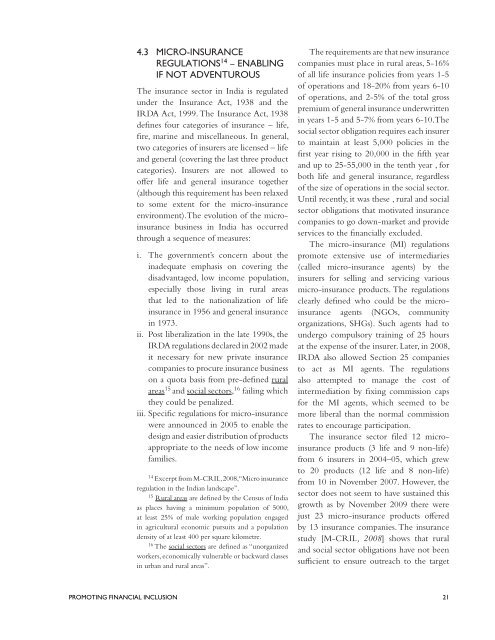Promoting Financial Inclusion - United Nations Development ...
Promoting Financial Inclusion - United Nations Development ...
Promoting Financial Inclusion - United Nations Development ...
Create successful ePaper yourself
Turn your PDF publications into a flip-book with our unique Google optimized e-Paper software.
4.3 MICRO-INSURANCE<br />
REGULATIONS 14 – ENABLING<br />
IF NOT ADVENTUROUS<br />
The insurance sector in India is regulated<br />
under the Insurance Act, 1938 and the<br />
IRDA Act, 1999. The Insurance Act, 1938<br />
defines four categories of insurance – life,<br />
fire, marine and miscellaneous. In general,<br />
two categories of insurers are licensed – life<br />
and general (covering the last three product<br />
categories). Insurers are not allowed to<br />
offer life and general insurance together<br />
(although this requirement has been relaxed<br />
to some extent for the micro-insurance<br />
environment).The evolution of the microinsurance<br />
business in India has occurred<br />
through a sequence of measures:<br />
i. The government’s concern about the<br />
inadequate emphasis on covering the<br />
disadvantaged, low income population,<br />
especially those living in rural areas<br />
that led to the nationalization of life<br />
insurance in 1956 and general insurance<br />
in 1973.<br />
ii. Post liberalization in the late 1990s, the<br />
IRDA regulations declared in 2002 made<br />
it necessary for new private insurance<br />
companies to procure insurance business<br />
on a quota basis from pre-defined rural<br />
areas 15 and social sectors, 16 failing which<br />
they could be penalized.<br />
iii. Specific regulations for micro-insurance<br />
were announced in 2005 to enable the<br />
design and easier distribution of products<br />
appropriate to the needs of low income<br />
families.<br />
14<br />
Excerpt from M-CRIL, 2008, “Micro insurance<br />
regulation in the Indian landscape”.<br />
15<br />
Rural areas are defined by the Census of India<br />
as places having a minimum population of 5000,<br />
at least 25% of male working population engaged<br />
in agricultural economic pursuits and a population<br />
density of at least 400 per square kilometre.<br />
16<br />
The social sectors are defined as “unorganized<br />
workers, economically vulnerable or backward classes<br />
in urban and rural areas”.<br />
The requirements are that new insurance<br />
companies must place in rural areas, 5-16%<br />
of all life insurance policies from years 1-5<br />
of operations and 18-20% from years 6-10<br />
of operations, and 2-5% of the total gross<br />
premium of general insurance underwritten<br />
in years 1-5 and 5-7% from years 6-10.The<br />
social sector obligation requires each insurer<br />
to maintain at least 5,000 policies in the<br />
first year rising to 20,000 in the fifth year<br />
and up to 25-55,000 in the tenth year , for<br />
both life and general insurance, regardless<br />
of the size of operations in the social sector.<br />
Until recently, it was these , rural and social<br />
sector obligations that motivated insurance<br />
companies to go down-market and provide<br />
services to the financially excluded.<br />
The micro-insurance (MI) regulations<br />
promote extensive use of intermediaries<br />
(called micro-insurance agents) by the<br />
insurers for selling and servicing various<br />
micro-insurance products. The regulations<br />
clearly defined who could be the microinsurance<br />
agents (NGOs, community<br />
organizations, SHGs). Such agents had to<br />
undergo compulsory training of 25 hours<br />
at the expense of the insurer. Later, in 2008,<br />
IRDA also allowed Section 25 companies<br />
to act as MI agents. The regulations<br />
also attempted to manage the cost of<br />
intermediation by fixing commission caps<br />
for the MI agents, which seemed to be<br />
more liberal than the normal commission<br />
rates to encourage participation.<br />
The insurance sector filed 12 microinsurance<br />
products (3 life and 9 non-life)<br />
from 6 insurers in 2004–05, which grew<br />
to 20 products (12 life and 8 non-life)<br />
from 10 in November 2007. However, the<br />
sector does not seem to have sustained this<br />
growth as by November 2009 there were<br />
just 23 micro-insurance products offered<br />
by 13 insurance companies. The insurance<br />
study [M-CRIL, 2008] shows that rural<br />
and social sector obligations have not been<br />
sufficient to ensure outreach to the target<br />
PROMOTING FINANCIAL INCLUSION 21

















